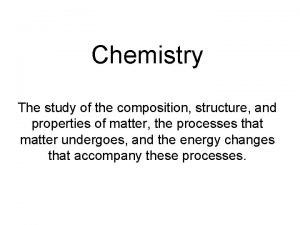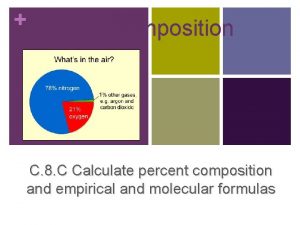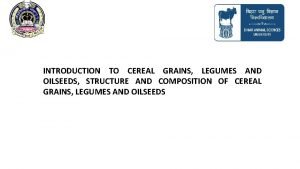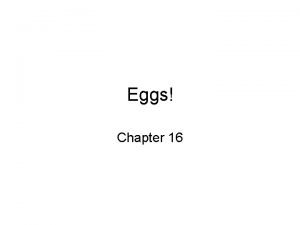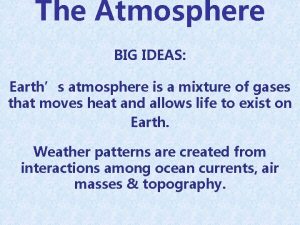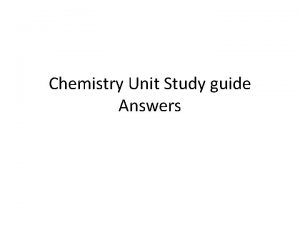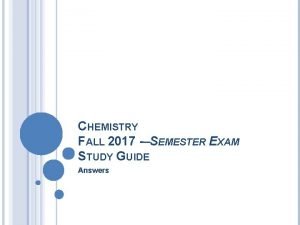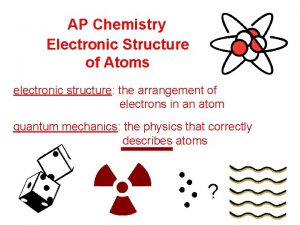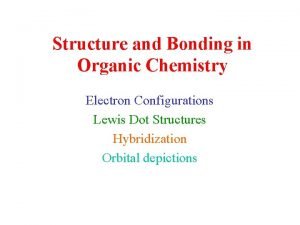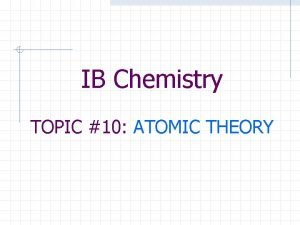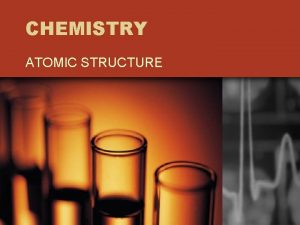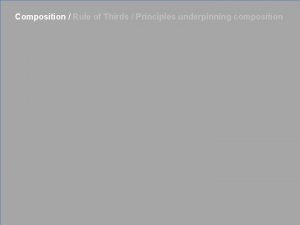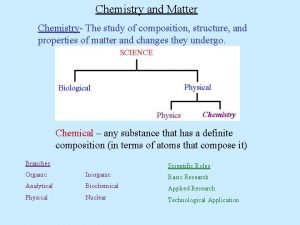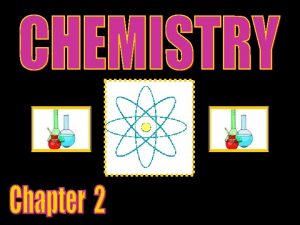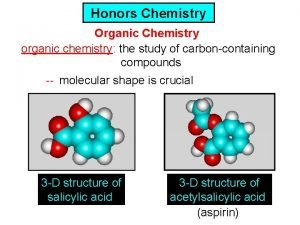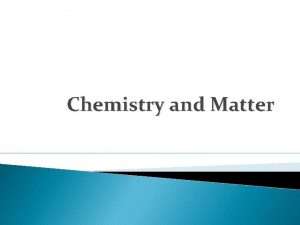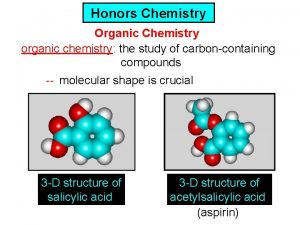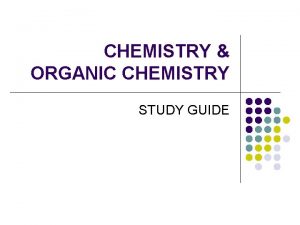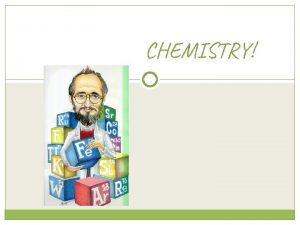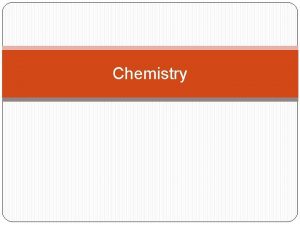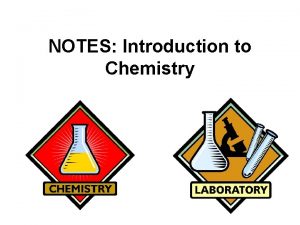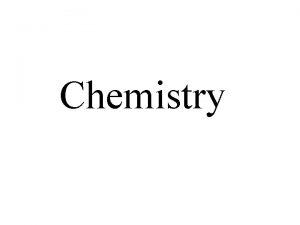CHEMISTRY Is the study of the composition structure


























- Slides: 26

CHEMISTRY: Is the study of the composition, structure, and properties of matter.

MATTER: Anything with mass and volume. Fun- Fact: Matter can be changed by energy…

Properties of matter: Every substance has unique characteristic properties Extensive properties - depend on the amount of matter present. Intensive properties – DO NOT depend on the amount of matter present.

Extensive Properties: • • Mass Volume Length Amount of energy present

Intensive properties: • • • Solubility Texture Luster Taste Color Hardness Clarity Ductility Radioactivity Malleability Compressability • • • Melting point State of matter Density p. H Viscosity Magnetism Boiling point Cohesion Odor Electrical resistance

Physical properties Can be measured or observed without altering the composition of the material. Color, Shape, Size, density, melting, freezing or boiling point, malleability, ductility.

Chemical Properties: A characteristic of a substance that indicates whether it can undergo a certain chemical change, transforming it into a different substance. Example: flammability!

Change

Physical changes Do not change the identity or composition of the substance. Examples: melting, boiling, condensation, dissolving, deposition, sublimination

Chemical Changes A change that produces a new type of matter with properties different from the original. Ex: tarnishing, cooking, rusting Also called “Chemical reactions”

Chemical Change Indicators Change of color Release of gas Formation of precipitate (solid) Changes in temperature (hot or cold) Changes in light

Chemical Reactions Can be written as a chemical equation: Carbon + Oxygen Carbon Dioxide Reactants are the substances that react Carbon and Oxygen Products are what is formed (carbon dioxide) Carbon Dioxide

Pure Substances: Elements Compounds

Elements are: ØThe simplest form of matter. ØMade up of exactly the same type of atoms. Ø Found on the periodic table. (Examples: Carbon, Uranium, Rubidium, Manganese, Neon)

Two kinds of Elements: • Monatomic Elements: • Elements that exist as a single, unbonded atom. Examples: C (carbon), S (sulfur), Al (aluminum) • Diatomic Elements: • Elements that exist in a paired state, but only bonded to atoms of the same element. Examples: O 2 (oxygen), N 2 (nitrogen)

Compounds are: Ø Pure substances Ø Made from atoms of two or more different elements in a fixed ratio. Ex: sodium chloride (Na. Cl), water (H 20)

MIXTURES Ø Homogeneous Ø Heterogeneous

Mixtures are: Ø Made up of two or more substances that can be separated using physical means. Ø Each component retains its own characteristics.

Homogeneous mixtures ØThe composition & properties are uniform throughout the mixture. ØAlso called “Solutions”. Examples: sugar water, sea water, brass, air

Homogeneous mixtures ØParticles cannot be seen with a microscope. ØParticles can’t be separated using a centrifuge or filter.

Homogeneous mixtures ØAre clear solutions. ØThe light goes straight through it when using the Tyndall effect test.

Heterogeneous Mixtures ØAre not solutions. ØThe composition and properties are not uniform throughout. Examples: granite, blood, wood, milk

Heterogeneous Mixtures ØThe particles can be seen with a microscope. ØThe particles can be separated using a centrifuge or filter.

Heterogenous Mixtures Two main types: ØColloids ØSuspensions

Colloids Øare heterogeneous mixtures where the particles never settle out. ØTyndall Effect-particles scatter light. ex: gelatin, fog

Suspensions ØAre heterogeneous mixtures containing a liquid in which visible particles settle out upon standing. Examples: Muddy water, cough syrup or anything that says “shake well” before using.
 Study of composition structure and properties
Study of composition structure and properties Percent composition examples
Percent composition examples Ib chemistry organic chemistry
Ib chemistry organic chemistry Inorganic vs organic chemistry
Inorganic vs organic chemistry Illustrate the structure and composition of cereal grains
Illustrate the structure and composition of cereal grains Label the parts of the eggs
Label the parts of the eggs Ideas about earth atmosphere
Ideas about earth atmosphere Chemistry unit 2 study guide answer key
Chemistry unit 2 study guide answer key Chapter 10 study guide the mole
Chapter 10 study guide the mole Chapter 11 stoichiometry study guide answer key
Chapter 11 stoichiometry study guide answer key Chemistry
Chemistry Personal eyeglasses provide as much protection as
Personal eyeglasses provide as much protection as Vce biology poster
Vce biology poster Atomic structure and properties ap chemistry
Atomic structure and properties ap chemistry First ionization energy of calcium
First ionization energy of calcium Ap chemistry chapter 7
Ap chemistry chapter 7 Ap chemistry electronic structure of atoms
Ap chemistry electronic structure of atoms Oxygen periodic trends
Oxygen periodic trends Octane lewis structure
Octane lewis structure Ib chemistry atomic structure
Ib chemistry atomic structure What is case series
What is case series Retrospective cohort study
Retrospective cohort study Critical examination in method study
Critical examination in method study Marty lobdell
Marty lobdell Phytogeography of india
Phytogeography of india Objectives of work study
Objectives of work study Distinguish between time study and motion study
Distinguish between time study and motion study
